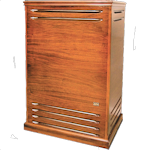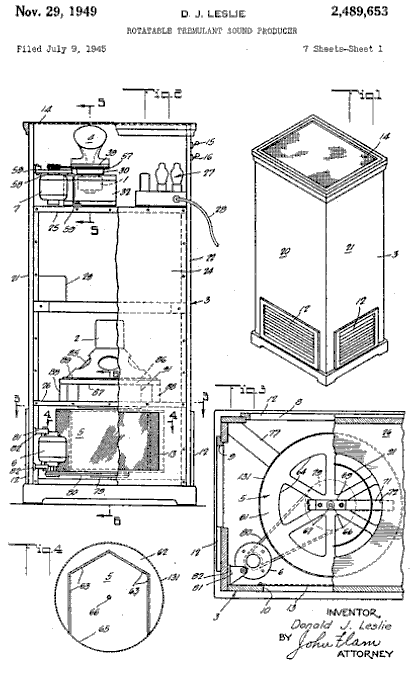
The Leslie speaker is a unique and iconic sound device primarily associated with the Hammond organ. Invented in the early 1940s, it has become synonymous with the distinctive swirling, rotating speaker effect heard in many classic rock, jazz, and blues recordings.
The Leslie speaker was invented by Don Leslie, an engineer and inventor, in 1941. Leslie was initially inspired by the desire to enhance the sound of the Hammond organ, which was becoming increasingly popular at the time. The goal was to create a speaker system that could replicate the rich, full-bodied sound of a pipe organ within a smaller, more portable instrument.
Leslie experimented with different speaker designs and configurations until he developed a system that used rotating speakers to create a unique modulation effect. His invention utilized a system of rotating horns and baffles to spread the sound around the room, producing a swirling, Doppler-like effect that enriched the sound of the organ.
Leslie's invention quickly gained popularity, especially among musicians playing Hammond organs, as it added a dynamic, spacious quality to their performances.
The Leslie speaker system typically consists of a wooden cabinet housing one or more speakers and a motorized mechanism that rotates these speakers. The key design elements include:

Horns and Baffles: The Leslie speaker contains multiple speakers, including a high-frequency driver (tweeter) and a low-frequency driver (woofer). These speakers are mounted within the cabinet and are directed towards spinning horns and baffles.
Rotating Mechanism: The hallmark of the Leslie speaker is its rotating system. The top rotor contains the high-frequency horn and is driven by an electric motor. The rotor spins at a constant speed, usually between 360 and 412 revolutions per minute (RPM). The lower rotor contains the bass driver and usually rotates more slowly than the top rotor, enhancing the unique acoustic effect.
Tone Cabinets: Leslie speakers are available in different models and sizes. The original Leslie design, the Model 122, featured a rotating upper horn and a stationary lower woofer. Later models introduced improvements and variations on the rotating speaker design.
Control and Modulation: Leslie speakers often include controls to adjust the speed of rotation (typically two or three speeds) and balance between the treble and bass speakers. The speed control allows musicians to achieve different modulation effects, ranging from a slow, atmospheric swirl to a fast, intense tremolo.
The Leslie speaker became an essential part of the Hammond organ's sound and was widely adopted by musicians across different genres. Its distinctive modulation effect added depth and character to recordings and live performances, influencing the development of rock, jazz, blues, and gospel music.
A prime example of the dynamic effect of which the Leslie speaker was capable can be heard in the Booker T. & The MGs classic instrumental "Time Is Tight".
Although originally developed for organ, the Leslie speaker was seen put to other uses.
John Lennon sang vocals though one. George Harrison and David Gilmour played their guitars through it. Jimi Hendrix’s lead guitar parts on “Little Wing” were run through a rotary speaker cabinet. Joe Walsh used it on guitar, piano, vocals, and organ on early James Gang albums.
The late Chris Cornell of Soundgarden wrote “Black Hole Sun” while playing his Gretsch guitar through a Leslie speaker, and the rotary speaker sound is one of the trademarks of the production on that song.
Over the years, various companies have manufactured Leslie speakers, adapting the original design while preserving its core rotating speaker concept. The Leslie effect has also been emulated in digital effects processors, but many musicians still prefer the authentic sound and feel of vintage Leslie speakers for their performances and recordings.
Interestingly, Leslie had originally offered a prototype to Hammond hoping for a contract, but it was rejected, spurring him to establish his own company, Electro Music in Pasadena, California. He would sell the company to CBS in 1965. In the 1980s, Hammond would finally acquire the speaker it had passed on some forty years earlier.
